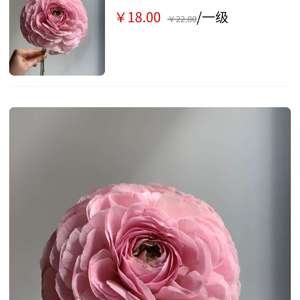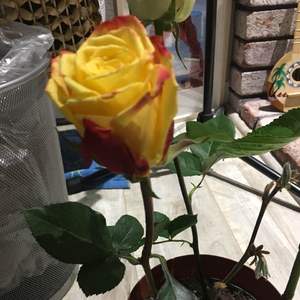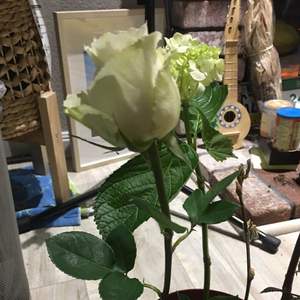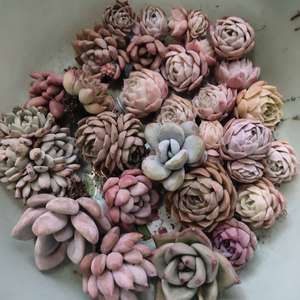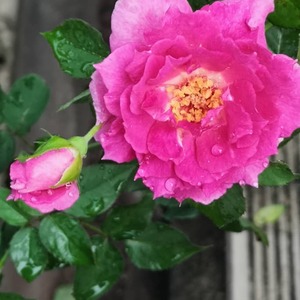文章
Miss Chen
2022年06月13日

Cotton rose (Hibiscus mutabilis) is a large flowering shrub with bright green, lobed, hairy leaves that stretch roughly 3 to 6 inches long and wide. The stems can grow tall and wide enough to become tree-like. But the plant's flowers are its real show-stopping feature.
They begin blooming in the summertime, starting off as a white or light pink color. Typically within one to three days, the color changes to a magenta pink and then a dark pink to red. The blooms then last for several more days. The shrub usually will have flowers at various stages of the color-change process on it all at once, providing exceptional visual interest. Fuzzy seed pods, whose cotton-like appearance gives the plant its common name, follow the flowers.
Cotton rose shrubs have a fast growth rate and should be planted in the spring.
Common Name Cotton rose
Botanical Name Hibiscus mutabilis
Family Malvaceae
Plant Type Shrub
Mature Size 6–15 ft. tall, 6–10 ft. wide
Sun Exposure Full, partial
Soil Type Loamy, well-drained
Soil pH Neutral, alkaline
Bloom Time Summer, fall
Flower Color White, pink, red
Hardiness Zones 7–11 (USDA)
Native Area Asia
Cotton Rose Care
Cotton rose can provide lots of drama in the landscape, yet it requires minimal maintenance. It’s not overly picky about its soil as long as there’s good drainage, and it can tolerate some drought. It’s even known to be deer-resistant.
You’ll typically have to prune annually, though the shrub usually doesn’t need extensive pruning. And plan to water and fertilize during the growing season.
Light
For best growth, plant your cotton rose in a spot that gets full sun, meaning at least six hours of direct sunlight on most days. The shrub also can tolerate partial shade, though it might not flower as profusely.
Soil
This shrub can grow in most soils with good drainage. But it does best in a loamy soil that’s rich in organic matter. A neutral to slightly alkaline soil pH is ideal.
Water
While cotton rose can tolerate some drought, it’s best to maintain a moderate amount of moisture during the growing season. A good rule of thumb is to water when the top 2 inches of soil dry out. Water minimally during the winter—just enough to prevent the soil from fully drying out. Try to avoid getting the foliage wet when watering, as this can promote fungal growth.
Temperature and Humidity
This is not a cold-hardy shrub. Frost will cause it to drop its leaves in the fall and enter dormancy. Then, it can tolerate temperatures slightly below freezing over the winter, but anything colder might damage or kill the shrub. Humidity typically isn’t a factor as long as adequate soil moisture and good air circulation around the shrub are maintained.
Fertilizer
Fertilizer isn't essential unless you have poor soil, but it can help to speed growth. Use a balanced fertilizer during the growing season, following label instructions.
Types of Cotton Rose
There are several types of cotton rose, including:
'Cotton Rose Nagoya': This cultivar features white flowers.
'Plenus': This cultivar is known for its double blooms.
'Rubra': Red flowers are the trademark of this cultivar.
Pruning
Prune your cotton rose in the late winter or early spring. Remove any damaged or diseased stems as they arise. Usually only a light pruning is necessary to shape growth. But if your shrub has become leggy and unsightly, you can cut it back almost to the ground. New shoots will quickly grow to fill in the space.
Propagating Cotton Rose
Cotton rose can be propagated by stem cuttings. Not only is this a cheap and easy way to get new plants, but it also allows you to put any stems that you pruned off to good use. The best time to take cuttings is in the late winter to early spring. Here’s how:
Trim off a piece of healthy stem that’s around 1 to 1.5 feet long. Cut just below a leaf node, and make your cut at a 45-degree angle.
Dip the cut end in rooting hormone.
Plant the cutting in a moist soilless potting mix. Use a 1-gallon container with drainage holes.
Place the container in a bright, south-facing window or in a sheltered area that gets partial sun outside if you live in a warmer climate.
Keep the soil lightly moist but never waterlogged, and roots should form in roughly four to six weeks.
How to Grow Cotton Rose From Seed
Direct sow cotton rose seeds in the spring; they germinate best when the temperatures are between roughly 55 and 65 degrees Fahrenheit. Plant them about 1/4 inch deep, and keep the soil moist but not waterlogged. You should see germination within a week or two, and plants can even flower in their first year if they're started early enough.
Potting and Repotting Cotton Rose
It’s possible to grow cotton rose in a pot, but this likely will stunt the shrub’s growth and diminish its blooms. Also, note that container plants generally need more frequent watering than those grown in the ground.
Use a quality all-purpose potting mix with good drainage. And select a container that allows for at least a few inches of extra space on all sides of the plant’s root ball. The container also should have drainage holes. Unglazed clay is a good material to allow excess soil moisture to evaporate through its walls. But you might want to consider using a grow bag because it will be lighter to move.
When you see roots coming out of the drainage holes and popping up from the soil line, it’s time to repot. It’s best to do this in the spring. Choose a container size up, and add fresh soil around the root ball.
Overwintering
In the colder parts of cotton rose's growing zones, the stems often naturally die back over the winter. But the shrub still should produce fresh growth in the spring. Plan to prune off the stems that have died back in the late winter to early spring. If you do it earlier as part of your garden's overwintering maintenance, this can damage the shrub.
If you’re growing your cotton rose in a container and live in the cooler parts of its growing zones, bring it into an unheated garage or shed over the winter. This will help to prevent the container soil from getting too cold and damaging the plant's roots.
Common Pests & Plant Diseases
Cotton rose is susceptible to some common garden pests, including aphids, mealybugs, whiteflies, spider mites, and scale. Infestations often can be treated with insecticidal soaps or even a strong spray of water.
Common diseases include leaf spot, southern stem blight, and powdery mildew. Remove any stems with signs of fungal growth. Also, aim to prevent fungal diseases by watering only at the base of the plant and maintaining good air flow around it.
How to Get Cotton Rose to Bloom
Cotton rose flowers are a saucer shape with four to five petals each. They stretch around 3 to 6 inches across. Blooming typically begins in the late summer and stretches into fall. The flowers won't provide fragrance for your garden, but they will attract many beneficial pollinators.
It's not essential to deadhead, or remove the spent blooms, but it can help to promote further blooming. However, this plant will typically bloom profusely on its own as well. Just make sure it has sufficient sunlight, moisture, and organic matter in the soil to support flowering.
Common Problems With Cotton Rose
When grown in the conditions it likes, cotton rose isn’t prone to serious problems. However, an inadequate environment can lead to some common issues.
Leaves Turning Yellow
Yellowing leaves can often be a sign of overwatering or underwatering. Make sure the soil is never waterlogged. But on the flip side, plan to water a little extra in hot weather.
Plant Leaves Falling Off
In the warmest parts of its growing zones, this shrub often holds onto its leaves year-round. But during the winter months in its cooler zones, it will naturally drop some or all of its leaves. This isn’t cause for concern, as it will regrow come spring. However, leaf drop during the growing season can be a sign of inadequate watering or disease.
FAQ
What's the difference between cotton roses and roses?
While they share a common name, cotton roses are actually members of the Hibiscus genus while roses are of the Rosa genus. However, both plants’ showy blooms do somewhat resemble each other.
Where should I place cotton rose outside my house?
The cotton rose can make for a dramatic specimen planting, providing a showy floral display toward the end of the growing season when many other plants have already wrapped up their blooming period. It also can be grown as a shrub border.
Can cotton rose be grown indoors?
It is not ideal to try to grow cotton rose shrubs indoors. They require direct sunlight to grow and bloom at their best. And they generally become too large to be a houseplant.
They begin blooming in the summertime, starting off as a white or light pink color. Typically within one to three days, the color changes to a magenta pink and then a dark pink to red. The blooms then last for several more days. The shrub usually will have flowers at various stages of the color-change process on it all at once, providing exceptional visual interest. Fuzzy seed pods, whose cotton-like appearance gives the plant its common name, follow the flowers.
Cotton rose shrubs have a fast growth rate and should be planted in the spring.
Common Name Cotton rose
Botanical Name Hibiscus mutabilis
Family Malvaceae
Plant Type Shrub
Mature Size 6–15 ft. tall, 6–10 ft. wide
Sun Exposure Full, partial
Soil Type Loamy, well-drained
Soil pH Neutral, alkaline
Bloom Time Summer, fall
Flower Color White, pink, red
Hardiness Zones 7–11 (USDA)
Native Area Asia
Cotton Rose Care
Cotton rose can provide lots of drama in the landscape, yet it requires minimal maintenance. It’s not overly picky about its soil as long as there’s good drainage, and it can tolerate some drought. It’s even known to be deer-resistant.
You’ll typically have to prune annually, though the shrub usually doesn’t need extensive pruning. And plan to water and fertilize during the growing season.
Light
For best growth, plant your cotton rose in a spot that gets full sun, meaning at least six hours of direct sunlight on most days. The shrub also can tolerate partial shade, though it might not flower as profusely.
Soil
This shrub can grow in most soils with good drainage. But it does best in a loamy soil that’s rich in organic matter. A neutral to slightly alkaline soil pH is ideal.
Water
While cotton rose can tolerate some drought, it’s best to maintain a moderate amount of moisture during the growing season. A good rule of thumb is to water when the top 2 inches of soil dry out. Water minimally during the winter—just enough to prevent the soil from fully drying out. Try to avoid getting the foliage wet when watering, as this can promote fungal growth.
Temperature and Humidity
This is not a cold-hardy shrub. Frost will cause it to drop its leaves in the fall and enter dormancy. Then, it can tolerate temperatures slightly below freezing over the winter, but anything colder might damage or kill the shrub. Humidity typically isn’t a factor as long as adequate soil moisture and good air circulation around the shrub are maintained.
Fertilizer
Fertilizer isn't essential unless you have poor soil, but it can help to speed growth. Use a balanced fertilizer during the growing season, following label instructions.
Types of Cotton Rose
There are several types of cotton rose, including:
'Cotton Rose Nagoya': This cultivar features white flowers.
'Plenus': This cultivar is known for its double blooms.
'Rubra': Red flowers are the trademark of this cultivar.
Pruning
Prune your cotton rose in the late winter or early spring. Remove any damaged or diseased stems as they arise. Usually only a light pruning is necessary to shape growth. But if your shrub has become leggy and unsightly, you can cut it back almost to the ground. New shoots will quickly grow to fill in the space.
Propagating Cotton Rose
Cotton rose can be propagated by stem cuttings. Not only is this a cheap and easy way to get new plants, but it also allows you to put any stems that you pruned off to good use. The best time to take cuttings is in the late winter to early spring. Here’s how:
Trim off a piece of healthy stem that’s around 1 to 1.5 feet long. Cut just below a leaf node, and make your cut at a 45-degree angle.
Dip the cut end in rooting hormone.
Plant the cutting in a moist soilless potting mix. Use a 1-gallon container with drainage holes.
Place the container in a bright, south-facing window or in a sheltered area that gets partial sun outside if you live in a warmer climate.
Keep the soil lightly moist but never waterlogged, and roots should form in roughly four to six weeks.
How to Grow Cotton Rose From Seed
Direct sow cotton rose seeds in the spring; they germinate best when the temperatures are between roughly 55 and 65 degrees Fahrenheit. Plant them about 1/4 inch deep, and keep the soil moist but not waterlogged. You should see germination within a week or two, and plants can even flower in their first year if they're started early enough.
Potting and Repotting Cotton Rose
It’s possible to grow cotton rose in a pot, but this likely will stunt the shrub’s growth and diminish its blooms. Also, note that container plants generally need more frequent watering than those grown in the ground.
Use a quality all-purpose potting mix with good drainage. And select a container that allows for at least a few inches of extra space on all sides of the plant’s root ball. The container also should have drainage holes. Unglazed clay is a good material to allow excess soil moisture to evaporate through its walls. But you might want to consider using a grow bag because it will be lighter to move.
When you see roots coming out of the drainage holes and popping up from the soil line, it’s time to repot. It’s best to do this in the spring. Choose a container size up, and add fresh soil around the root ball.
Overwintering
In the colder parts of cotton rose's growing zones, the stems often naturally die back over the winter. But the shrub still should produce fresh growth in the spring. Plan to prune off the stems that have died back in the late winter to early spring. If you do it earlier as part of your garden's overwintering maintenance, this can damage the shrub.
If you’re growing your cotton rose in a container and live in the cooler parts of its growing zones, bring it into an unheated garage or shed over the winter. This will help to prevent the container soil from getting too cold and damaging the plant's roots.
Common Pests & Plant Diseases
Cotton rose is susceptible to some common garden pests, including aphids, mealybugs, whiteflies, spider mites, and scale. Infestations often can be treated with insecticidal soaps or even a strong spray of water.
Common diseases include leaf spot, southern stem blight, and powdery mildew. Remove any stems with signs of fungal growth. Also, aim to prevent fungal diseases by watering only at the base of the plant and maintaining good air flow around it.
How to Get Cotton Rose to Bloom
Cotton rose flowers are a saucer shape with four to five petals each. They stretch around 3 to 6 inches across. Blooming typically begins in the late summer and stretches into fall. The flowers won't provide fragrance for your garden, but they will attract many beneficial pollinators.
It's not essential to deadhead, or remove the spent blooms, but it can help to promote further blooming. However, this plant will typically bloom profusely on its own as well. Just make sure it has sufficient sunlight, moisture, and organic matter in the soil to support flowering.
Common Problems With Cotton Rose
When grown in the conditions it likes, cotton rose isn’t prone to serious problems. However, an inadequate environment can lead to some common issues.
Leaves Turning Yellow
Yellowing leaves can often be a sign of overwatering or underwatering. Make sure the soil is never waterlogged. But on the flip side, plan to water a little extra in hot weather.
Plant Leaves Falling Off
In the warmest parts of its growing zones, this shrub often holds onto its leaves year-round. But during the winter months in its cooler zones, it will naturally drop some or all of its leaves. This isn’t cause for concern, as it will regrow come spring. However, leaf drop during the growing season can be a sign of inadequate watering or disease.
FAQ
What's the difference between cotton roses and roses?
While they share a common name, cotton roses are actually members of the Hibiscus genus while roses are of the Rosa genus. However, both plants’ showy blooms do somewhat resemble each other.
Where should I place cotton rose outside my house?
The cotton rose can make for a dramatic specimen planting, providing a showy floral display toward the end of the growing season when many other plants have already wrapped up their blooming period. It also can be grown as a shrub border.
Can cotton rose be grown indoors?
It is not ideal to try to grow cotton rose shrubs indoors. They require direct sunlight to grow and bloom at their best. And they generally become too large to be a houseplant.
0
0
文章
Miss Chen
2021年07月15日

Rose of Sharon (Hibiscus syriacus) bears many blooms, and its attractive flowers are its main selling point. As with other types of hibiscus, its flowers bear a striking stamen. Another feature giving the shrub value is its relatively late period of blooming (in many northern climates, it blooms in August). Rose of Sharon is thus able to offer white, red, lavender, or light blue blooms when many flowering shrubs have long since ceased blooming. Late-summer flowering shrubs can help gardeners manage the sequence of bloom in their landscapes.
Rose of Sharon is classified by botanists as a shrub, but it can be pruned to form one main trunk so that it grows more like a tree. It can also be used for espalier. Its natural shrub form is multi-stemmed and vase-shaped. It has toothed green leaves that do not provide fall color. It can grow up to 24 inches each year and can be planted in spring or fall.
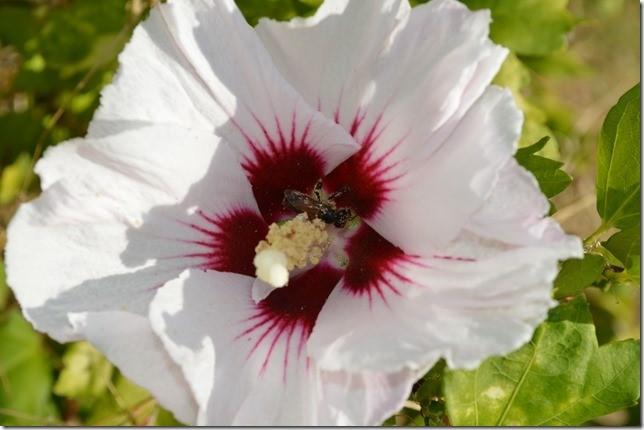
Botanical Name Hibiscus syriacus
Common Name Rose of Sharon, althea, Korean rose, rose mallow, Chinese hibiscus
Plant Type Shrub
Mature Size 8-12 ft. tall, 6-10 ft. wide
Sun Exposure Full sun to part shade
Soil Type Moist
Soil pH Neutral to acidic, alkaline
Bloom Time Late summer, early fall
Flower Color White, red, lavender, light blue
Hardiness Zones 5 to 9 (USDA)
Native Area China, India
Toxicity Non-toxic
Rose of Sharon Care
Rose of Sharon is tolerant of air pollution, heat, humidity, poor soil, and drought.1 This species has naturalized well in many areas and can become invasive if its growth is not monitored.
This shrub is primarily used as a specimen plant, hedge plant, and foundation shrub. Its attractive and plentiful blooms make it fully capable of holding its own as a specimen. The ability to shape rose of Sharon also makes the shrub a prime candidate for hedges. But since this bush is deciduous, it is an effective privacy hedge only in summer (select one of the evergreen shrubs to gain privacy all year).
Light
Rose of Sharon prefers full sun. Older bushes may fall prey to fungal damage if they are grown in shaded areas where moisture is likely to be high.2
Soil
This plant thrives in rich soil. It can tolerate many soil types, including sand, clay, chalk, and loam. It prefers nutrient-rich soil but can survive in poor soil, too. Rose of Sharon thrives in a wide range of soil pH from 5.5 to 7.5.
Water
The plant is reasonably drought-tolerant. In fact, if your rose of Sharon has yellow leaves, it could be due to overwatering, rather than to a lack of water.3
Temperature and Humidity
A heat lover, this shrub is also prized by growers in the southeastern U.S. who seek plants that can stand up to summer's heat. It is also tolerant of a wide range of humidity conditions.
Fertilizer
Fertilizer is recommended (although not mandatory for established shrubs). Use a slow-release fertilizer for shrubs and trees, feeding in late winter or early spring. If you wish to grow organically, work compost gently into the soil around the root zone and water it into the earth.
Rose of Sharon Varieties
Rose of Sharon can be found in a number of different colors. These are some popular varieties:
'Blue Chiffon': This cultivar has double flowers with a purple-blue tinge (they're not really blue) that bloom from mid-summer into autumn. What makes the flower so beautiful is the presence of inner petals that surround the stamen, giving the flowers a frilly look. It grows 8 to 12 feet tall, with a spread of 6 to 10 feet.
'Sugar Tip': The name of this cultivar refers to its variegated leaves with creamy-white edging. It has pink double flowers and grows six to eight feet tall and four to six feet wide.
'White Chiffon': This variety is graced with white flowers that are solid: they have no distinct center, or throat, because the petal is totally white. The shrub grows 6 to 8 feet tall and 4 to 6 feet wide.
'Red Heart': This shrub's flowers are ruffled and have a bicolored look with white petals and dark red centers. Lovers of low-maintenance landscaping will be glad to hear that this is a sterile cultivar, so there will not be any seedlings to remove.
Propagating Rose of Sharon
The best way to propagate rose of Sharon plants is by making stem cuttings and potting them.
Cut several pencil-wide branches of rose of Sharon that have several leaves or leaf buds. Cut the stems 4 to 6 inches long and remove the leaves from the bottom half of the stem.
Dip the end of the stem in rooting hormone. Plant the bottom third or bottom half of each stem.
Place a piece of clear plastic over the top of each pot. Water well.
Put your pots in a spot with shade or indirect light. Remove the plastic in seven days. Check the pots every few days to make sure the potting mixture remains moist. Add more water if needed, but do not let the soil get soggy.
Check the cuttings for roots in one to two months. Pull gently on each stem; if it resists, the stem has rooted. You also should also see new leaves form on the branch stems that have rooted.
Grow them larger, at least 2 inches of growth, before planting them in the garden.
Pruning
Although naturally a multi-stemmed shrub, this plant can be trained through pruning to have just one main trunk; thus, some people refer to it as the rose of Sharon "tree." Prune in late winter or early spring, since this is one of the shrubs that blooms on the current season's growth. It is easiest to give rose of Sharon its desired shape by pruning it accordingly during its first two seasons. It can also be trained for espalier (grown flat against a supporting structure).

Also, do not give up on rose of Sharon, thinking it is dead just because it has not leafed out by early summer. This shrub not only blooms late but leaves out late as well, so be patient.
Common Pests/Diseases
The chief pest problem for this bush is Japanese beetle infestations.4 Japanese beetles are somewhat easier to control than many other insect pests because they are large enough to spot immediately before they have done too much damage to your plants. The easiest and safest way to kill them is to pick or shake them off by hand, dropping them into a container filled with soapy water. The insect breathes through its skin, so a coating of soap over its body effectively suffocates it.
Rose of Sharon is classified by botanists as a shrub, but it can be pruned to form one main trunk so that it grows more like a tree. It can also be used for espalier. Its natural shrub form is multi-stemmed and vase-shaped. It has toothed green leaves that do not provide fall color. It can grow up to 24 inches each year and can be planted in spring or fall.

Botanical Name Hibiscus syriacus
Common Name Rose of Sharon, althea, Korean rose, rose mallow, Chinese hibiscus
Plant Type Shrub
Mature Size 8-12 ft. tall, 6-10 ft. wide
Sun Exposure Full sun to part shade
Soil Type Moist
Soil pH Neutral to acidic, alkaline
Bloom Time Late summer, early fall
Flower Color White, red, lavender, light blue
Hardiness Zones 5 to 9 (USDA)
Native Area China, India
Toxicity Non-toxic
Rose of Sharon Care
Rose of Sharon is tolerant of air pollution, heat, humidity, poor soil, and drought.1 This species has naturalized well in many areas and can become invasive if its growth is not monitored.
This shrub is primarily used as a specimen plant, hedge plant, and foundation shrub. Its attractive and plentiful blooms make it fully capable of holding its own as a specimen. The ability to shape rose of Sharon also makes the shrub a prime candidate for hedges. But since this bush is deciduous, it is an effective privacy hedge only in summer (select one of the evergreen shrubs to gain privacy all year).
Light
Rose of Sharon prefers full sun. Older bushes may fall prey to fungal damage if they are grown in shaded areas where moisture is likely to be high.2
Soil
This plant thrives in rich soil. It can tolerate many soil types, including sand, clay, chalk, and loam. It prefers nutrient-rich soil but can survive in poor soil, too. Rose of Sharon thrives in a wide range of soil pH from 5.5 to 7.5.
Water
The plant is reasonably drought-tolerant. In fact, if your rose of Sharon has yellow leaves, it could be due to overwatering, rather than to a lack of water.3
Temperature and Humidity
A heat lover, this shrub is also prized by growers in the southeastern U.S. who seek plants that can stand up to summer's heat. It is also tolerant of a wide range of humidity conditions.
Fertilizer
Fertilizer is recommended (although not mandatory for established shrubs). Use a slow-release fertilizer for shrubs and trees, feeding in late winter or early spring. If you wish to grow organically, work compost gently into the soil around the root zone and water it into the earth.
Rose of Sharon Varieties
Rose of Sharon can be found in a number of different colors. These are some popular varieties:
'Blue Chiffon': This cultivar has double flowers with a purple-blue tinge (they're not really blue) that bloom from mid-summer into autumn. What makes the flower so beautiful is the presence of inner petals that surround the stamen, giving the flowers a frilly look. It grows 8 to 12 feet tall, with a spread of 6 to 10 feet.
'Sugar Tip': The name of this cultivar refers to its variegated leaves with creamy-white edging. It has pink double flowers and grows six to eight feet tall and four to six feet wide.
'White Chiffon': This variety is graced with white flowers that are solid: they have no distinct center, or throat, because the petal is totally white. The shrub grows 6 to 8 feet tall and 4 to 6 feet wide.
'Red Heart': This shrub's flowers are ruffled and have a bicolored look with white petals and dark red centers. Lovers of low-maintenance landscaping will be glad to hear that this is a sterile cultivar, so there will not be any seedlings to remove.
Propagating Rose of Sharon
The best way to propagate rose of Sharon plants is by making stem cuttings and potting them.
Cut several pencil-wide branches of rose of Sharon that have several leaves or leaf buds. Cut the stems 4 to 6 inches long and remove the leaves from the bottom half of the stem.
Dip the end of the stem in rooting hormone. Plant the bottom third or bottom half of each stem.
Place a piece of clear plastic over the top of each pot. Water well.
Put your pots in a spot with shade or indirect light. Remove the plastic in seven days. Check the pots every few days to make sure the potting mixture remains moist. Add more water if needed, but do not let the soil get soggy.
Check the cuttings for roots in one to two months. Pull gently on each stem; if it resists, the stem has rooted. You also should also see new leaves form on the branch stems that have rooted.
Grow them larger, at least 2 inches of growth, before planting them in the garden.
Pruning
Although naturally a multi-stemmed shrub, this plant can be trained through pruning to have just one main trunk; thus, some people refer to it as the rose of Sharon "tree." Prune in late winter or early spring, since this is one of the shrubs that blooms on the current season's growth. It is easiest to give rose of Sharon its desired shape by pruning it accordingly during its first two seasons. It can also be trained for espalier (grown flat against a supporting structure).

Also, do not give up on rose of Sharon, thinking it is dead just because it has not leafed out by early summer. This shrub not only blooms late but leaves out late as well, so be patient.
Common Pests/Diseases
The chief pest problem for this bush is Japanese beetle infestations.4 Japanese beetles are somewhat easier to control than many other insect pests because they are large enough to spot immediately before they have done too much damage to your plants. The easiest and safest way to kill them is to pick or shake them off by hand, dropping them into a container filled with soapy water. The insect breathes through its skin, so a coating of soap over its body effectively suffocates it.
0
0
文章
莹723
2021年01月25日

These low-light varieties won't want anything to do with your already crowded windowsill.
1.Calathea
Its patterned leaves (in colors like rose, white, and yellow) makes this plant a welcome addition to any room — and too much direct light might actually fade its lovely markings.

2.Dieffenbachia
Filtered light is best for this plant. Try using a curtain as a barrier between it and the sun, especially during the the spring and summer when the plant is producing new, tender leaves.

3.Dragon Tree
Spiky leaves that grow upwards and have a red outline makes the name of this plant absolutely perfect. But direct sunlight could damage them – so give this guy some sun and some shade.

4.Spider Plants
This plant's adaptability makes it super easy to grow and therefore quite popular — it's also easy to propagate and share with others. It can stand up to a lot of neglect, and will thrive in indirect light.

5.Heart-Leaf Philodendron
The sweetheart plant (a nickname given because of the shape of its glossy leaves) can stand dim rooms, but requires pinching to prevent it from growing in long, single stems.

6.Bromeliads
Didn't expect to find a tropical plant on this list? This houseplant can actually survive on florescent light alone and thrives in humid conditions like bathrooms.

7.Peace Lily
If you often forget to water your plants, pick up one of these low-maintenance ones: It actually needs to dry out between waterings, meaning you can wait longer.

8.Chinese Evergreen
Since this plant is one of the most durable indoor plants (it does quite well in low light) and only needs to be fertilized once or twice a year, it's ideal for beginner gardeners.

9.Snake Plant
While the name is fun, this succulent is pretty tame when it comes to maintenance. More light will help it grow, but it can tolerate darkness—just watch out for root rot caused by overwatering.

10.Cast-Iron Plant
The leathery leaves on this houseplant are super tolerant not only to low light but also heat, cold, you name it. However, patience is required as it grows super slowly.

1.Calathea
Its patterned leaves (in colors like rose, white, and yellow) makes this plant a welcome addition to any room — and too much direct light might actually fade its lovely markings.

2.Dieffenbachia
Filtered light is best for this plant. Try using a curtain as a barrier between it and the sun, especially during the the spring and summer when the plant is producing new, tender leaves.

3.Dragon Tree
Spiky leaves that grow upwards and have a red outline makes the name of this plant absolutely perfect. But direct sunlight could damage them – so give this guy some sun and some shade.

4.Spider Plants
This plant's adaptability makes it super easy to grow and therefore quite popular — it's also easy to propagate and share with others. It can stand up to a lot of neglect, and will thrive in indirect light.

5.Heart-Leaf Philodendron
The sweetheart plant (a nickname given because of the shape of its glossy leaves) can stand dim rooms, but requires pinching to prevent it from growing in long, single stems.

6.Bromeliads
Didn't expect to find a tropical plant on this list? This houseplant can actually survive on florescent light alone and thrives in humid conditions like bathrooms.

7.Peace Lily
If you often forget to water your plants, pick up one of these low-maintenance ones: It actually needs to dry out between waterings, meaning you can wait longer.

8.Chinese Evergreen
Since this plant is one of the most durable indoor plants (it does quite well in low light) and only needs to be fertilized once or twice a year, it's ideal for beginner gardeners.

9.Snake Plant
While the name is fun, this succulent is pretty tame when it comes to maintenance. More light will help it grow, but it can tolerate darkness—just watch out for root rot caused by overwatering.

10.Cast-Iron Plant
The leathery leaves on this houseplant are super tolerant not only to low light but also heat, cold, you name it. However, patience is required as it grows super slowly.

1
0
文章
ritau
2020年05月21日

A rose is a woody perennial flowering plant of the genus Rosa, in the family Rosaceae, or the flower it bears. There are over three hundred species and thousands of cultivars. They form a group of plants that can be erect shrubs, climbing, or trailing, with stems that are often armed with sharp prickles. Flowers vary in size and shape and are usually large and showy, in colours ranging from white through yellows and reds. Most species are native to Asia, with smaller numbers native to Europe, North America, and northwestern Africa. Species, cultivars and hybrids are all widely grown for their beauty and often are fragrant. Roses have acquired cultural significance in many societies. Rose plants range in size from compact, miniature roses, to climbers that can reach seven meters in height. Different species hybridize easily, and this has been used in the development of the wide range of garden roses.

The long cultural history of the rose has led to it being used often as a symbol. In ancient Greece, the rose was closely associated with the goddess Aphrodite. In the Iliad, Aphrodite protects the body of Hector using the "immortal oil of the rose" and the archaic Greek lyric poet Ibycus praises a beautiful youth saying that Aphrodite nursed him "among rose blossoms". The second-century AD Greek travel writer Pausanias associates the rose with the story of Adonis and states that the rose is red because Aphrodite wounded herself on one of its thorns and stained the flower red with her blood. Book Eleven of the ancient Roman novel The Golden Ass by Apuleius contains a scene in which the goddess Isis, who is identified with Venus, instructs the main character, Lucius, who has been transformed into a donkey, to eat rose petals from a crown of roses worn by a priest as part of a religious procession in order to regain his humanity.
Following the Christianization of the Roman Empire, the rose became identified with the Virgin Mary. The color of the rose and the number of roses received has symbolic representation. The rose symbol eventually led to the creation of the rosary and other devotional prayers in Christianity.
Ever since the 1400s, the Franciscans have had a Crown Rosary of the Seven Joys of the Blessed Virgin Mary. In the 1400s and 1500s, the Carthusians promoted the idea of sacred mysteries associated with the rose symbol and rose gardens. Albrecht Dürer's painting The Feast of the Rosary (1506) depicts the Virgin Mary distributing garlands of roses to her worshippers.
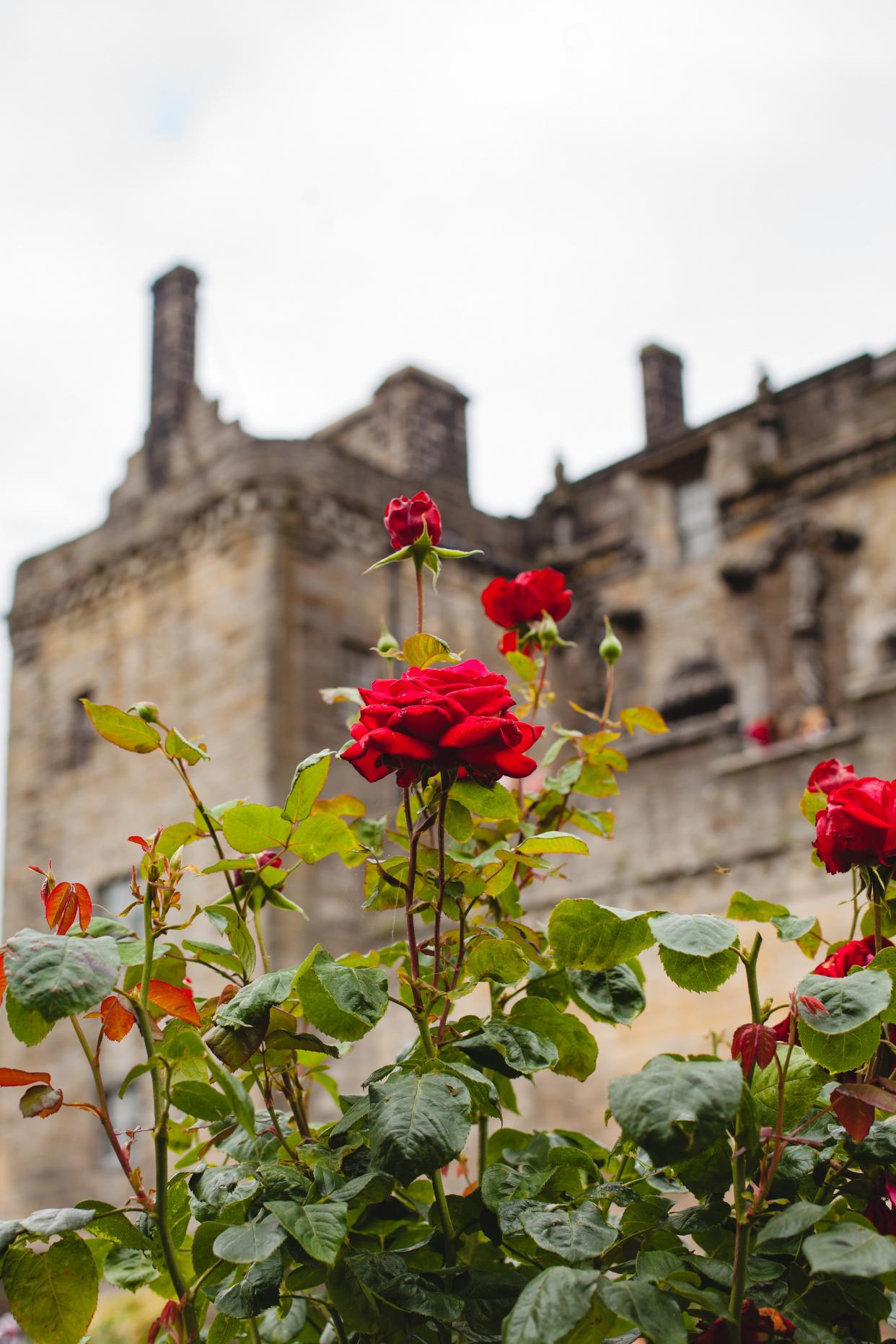
Roses symbolised the Houses of York and Lancaster in a conflict known as the Wars of the Roses.
Roses are a favored subject in art and appear in portraits, illustrations, on stamps, as ornaments or as architectural elements. The Luxembourg-born Belgian artist and botanist Pierre-Joseph Redouté is known for his detailed watercolours of flowers, particularly roses.
Henri Fantin-Latour was also a prolific painter of still life, particularly flowers including roses. The rose 'Fantin-Latour' was named after the artist.
Other impressionists including Claude Monet, Paul Cézanne and Pierre-Auguste Renoir have paintings of roses among their works.
In 1986 President Ronald Reagan signed legislation to make the rose the floral emblem of the United States.

The long cultural history of the rose has led to it being used often as a symbol. In ancient Greece, the rose was closely associated with the goddess Aphrodite. In the Iliad, Aphrodite protects the body of Hector using the "immortal oil of the rose" and the archaic Greek lyric poet Ibycus praises a beautiful youth saying that Aphrodite nursed him "among rose blossoms". The second-century AD Greek travel writer Pausanias associates the rose with the story of Adonis and states that the rose is red because Aphrodite wounded herself on one of its thorns and stained the flower red with her blood. Book Eleven of the ancient Roman novel The Golden Ass by Apuleius contains a scene in which the goddess Isis, who is identified with Venus, instructs the main character, Lucius, who has been transformed into a donkey, to eat rose petals from a crown of roses worn by a priest as part of a religious procession in order to regain his humanity.
Following the Christianization of the Roman Empire, the rose became identified with the Virgin Mary. The color of the rose and the number of roses received has symbolic representation. The rose symbol eventually led to the creation of the rosary and other devotional prayers in Christianity.
Ever since the 1400s, the Franciscans have had a Crown Rosary of the Seven Joys of the Blessed Virgin Mary. In the 1400s and 1500s, the Carthusians promoted the idea of sacred mysteries associated with the rose symbol and rose gardens. Albrecht Dürer's painting The Feast of the Rosary (1506) depicts the Virgin Mary distributing garlands of roses to her worshippers.

Roses symbolised the Houses of York and Lancaster in a conflict known as the Wars of the Roses.
Roses are a favored subject in art and appear in portraits, illustrations, on stamps, as ornaments or as architectural elements. The Luxembourg-born Belgian artist and botanist Pierre-Joseph Redouté is known for his detailed watercolours of flowers, particularly roses.
Henri Fantin-Latour was also a prolific painter of still life, particularly flowers including roses. The rose 'Fantin-Latour' was named after the artist.
Other impressionists including Claude Monet, Paul Cézanne and Pierre-Auguste Renoir have paintings of roses among their works.
In 1986 President Ronald Reagan signed legislation to make the rose the floral emblem of the United States.
0
0
文章
ritau
2020年02月02日

“It is the time you have wasted for your rose that makes your rose so important.”
“You're beautiful, but you're empty...One couldn't die for you. Of course, an ordinary passerby would think my rose looked just like you. But my rose, all on her own, is more important than all of you together, since she's the one I've watered. Since she's the one I put under glass, since she's the one I sheltered behind the screen. Since she's the one for whom I killed the caterpillars (except the two or three butterflies). Since she's the one I listened to when she complained, or when she boasted, or even sometimes when she said nothing at all. Since she's my rose.”
― Antoine de Saint-Exupéry, The Little Prince

“We can complain because rose bushes have thorns, or rejoice because thorns have roses.”
― Alphonse Karr, A Tour Round My Garden
“Did you hear about the rose that grew from a crack in the concrete? Proving nature's laws wrong, it learned to walk without having feet. Funny, it seems to by keeping it's dreams; it learned to breathe fresh air. Long live the rose that grew from concrete when no one else even cared.”
― Tupac Shakur, The Rose That Grew from Concrete
“It was June, and the world smelled of roses. The sunshine was like powdered gold over the grassy hillside.”
― Maud Hart Lovelace, Betsy-Tacy and Tib
“I feel as if I had opened a book and found roses of yesterday sweet and fragrant, between its leaves.”
― L.M. Montgomery, Anne of the Island

“Feeling at peace, however fragilely, made it easy to slip into the visionary end of the dark-sight. The rose shadows said that they loved the sun, but that they also loved the dark, where their roots grew through the lightless mystery of the earth. The roses said: You do not have to choose. ”
― Robin McKinley, Sunshine
“Love is like the wild rose-briar; Friendship like the holly-tree. The holly is dark when the rose-briar blooms, but which will bloom most constantly?”
― Emily Brontë, The Complete Poems
“Princess,” he whispered against her ear. “My beautiful, beautiful princess. I want to spoil you. Pamper you. Indulge you.”
― Teresa Medeiros, A Whisper of Roses
“An idealist is one who, on noticing that a rose smells better than a cabbage, concludes that it makes a better soup.”
― H.L. Mencken, A Book of Burlesques

“You're beautiful, but you're empty...One couldn't die for you. Of course, an ordinary passerby would think my rose looked just like you. But my rose, all on her own, is more important than all of you together, since she's the one I've watered. Since she's the one I put under glass, since she's the one I sheltered behind the screen. Since she's the one for whom I killed the caterpillars (except the two or three butterflies). Since she's the one I listened to when she complained, or when she boasted, or even sometimes when she said nothing at all. Since she's my rose.”
― Antoine de Saint-Exupéry, The Little Prince

“We can complain because rose bushes have thorns, or rejoice because thorns have roses.”
― Alphonse Karr, A Tour Round My Garden
“Did you hear about the rose that grew from a crack in the concrete? Proving nature's laws wrong, it learned to walk without having feet. Funny, it seems to by keeping it's dreams; it learned to breathe fresh air. Long live the rose that grew from concrete when no one else even cared.”
― Tupac Shakur, The Rose That Grew from Concrete
“It was June, and the world smelled of roses. The sunshine was like powdered gold over the grassy hillside.”
― Maud Hart Lovelace, Betsy-Tacy and Tib
“I feel as if I had opened a book and found roses of yesterday sweet and fragrant, between its leaves.”
― L.M. Montgomery, Anne of the Island

“Feeling at peace, however fragilely, made it easy to slip into the visionary end of the dark-sight. The rose shadows said that they loved the sun, but that they also loved the dark, where their roots grew through the lightless mystery of the earth. The roses said: You do not have to choose. ”
― Robin McKinley, Sunshine
“Love is like the wild rose-briar; Friendship like the holly-tree. The holly is dark when the rose-briar blooms, but which will bloom most constantly?”
― Emily Brontë, The Complete Poems
“Princess,” he whispered against her ear. “My beautiful, beautiful princess. I want to spoil you. Pamper you. Indulge you.”
― Teresa Medeiros, A Whisper of Roses
“An idealist is one who, on noticing that a rose smells better than a cabbage, concludes that it makes a better soup.”
― H.L. Mencken, A Book of Burlesques

0
0



